Batteries create critical cobalt situation
Less cobalt per battery does not overcome volume forecast
Last updated 6/22/2020 at 11:02am
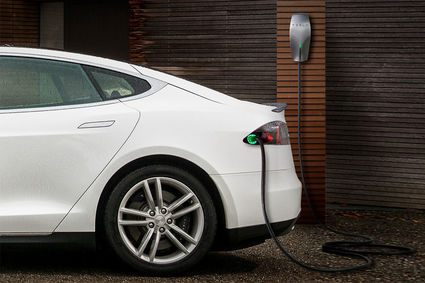
Tesla Inc.
Due to supply complications, Tesla and other electric vehicle manufacturers are looking for ways to reduce the amount of cobalt required in the lithium-ion rechargeable batteries that power their EVs.
Cobalt is a critical safety ingredient in the cathodes of lithium-ion batteries powering the ever-increasing number of electric vehicles traveling global highways and a plethora of cordless electrical devices.
"Globally, the leading use is in the manufacture of cathode materials for rechargeable batteries – primarily lithium-ion, nickel-cadmium, and nickel-metal-hydride batteries – which are used in consumer electronics, electric and hybrid-electric vehicles, energy storage units, and power tools," the United States Geological Survey wrote in a 2018 report on critical minerals
As a result, the rechargeable battery sector will drive the demand of cobalt higher, faster than the mining sector will bring new supplies of the battery metal to market.
According to Benchmark Mineral Intelligence, an analytical firm that specializes in the lithium-ion battery supply chain, 54,354 metric tons of cobalt went into lithium-ion batteries alone during 2017. The analyst forecasts that the amount of cobalt going into batteries will climb to 276,401 metric tons by 2028, skyrocketing the demand side of the equation over the next decade.
The USGS calculates that roughly 140,000 metric tons of cobalt was mined globally during 2018. Even with substantial supply from recycling, the current mine output falls well short of the cobalt needed for batteries.
This limited supply could affect more than the battery sector.
"Cobalt's diverse uses, particularly in parts for aircraft turbine engines; in numerous magnet applications, including marine propulsion systems, missile guidance systems, sensors, and radar; and in machine tools-make it important to the U.S. military and civilian industries," USGS wrote.
The United States currently gets roughly 61 percent of its cobalt supply from overseas suppliers, with most of the balance coming from recycling.
"This high reliance on imports increases the potential for supply disruption and high prices during supply shortfalls," according to the USGS.
This import-reliance is further complicated by the fact that the Democratic Republic of Congo (DRC), a country considered politically and socially unstable, supplied 69 percent of the world's new cobalt supply in 2018.
Combined, these factors have prompted the USGS to place cobalt on the final list of 35 minerals deemed critical to the United States.
There are a number of deposits and prospects in Alaska that could provide the United States domestic sources of cobalt, the most advanced of which is the large and high-grade Bornite copper-cobalt deposit at Trilogy Metal Inc.'s Upper Kobuk Mineral Project in the Ambler Mining District.
"It has become imperative that the United States secure its own sources of critical minerals," said Trilogy Metals President and CEO Rick Van Nieuwenhuyse.
Supply-side complications
Having around 70 percent of the world's cobalt supply coming from DRC has created a dilemma for electric automobile manufactures and their customers.
"This country has a high-risk index for doing business owing to poor infrastructure, resource nationalism, a high perception of corruption, and a lack of transparency as well as wars," USGS wrote in its cobalt report.
While Amnesty International believes EVs have an important role to play in curbing climate change, they are urging carmakers to consider the human costs associated with the cobalt that goes into these vehicles.
"Without radical changes, the batteries which power green vehicles will continue to be tainted by human rights abuses," said Amnesty International Secretary General Kumi Naidoo.
In March, the global organization pressed its vision for a battery that does not harm human rights or the environment at the Nordic Electric Vehicle Summit in Oslo.
Coupled with pressure from socially conscious EV consumers, this call for ethical batteries has automobile and lithium-ion battery manufacturers looking for solutions, including less cobalt-intensive recipes for cathodes.
Tesla Inc., which produced roughly 350,000 cars and dominated the U.S. luxury vehicle market in 2018, is among the EV manufacturers developing cathode chemistries that require less cobalt.
"Cells used in Model 3 are the highest energy density cells used in any electric vehicle," Tesla CEO Elon Musk penned in a 2018 letter to shareholders. "We have achieved this by significantly reducing cobalt content per battery pack while increasing nickel content and still maintaining superior thermal stability."
While Tesla and other rechargeable battery manufacturers are looking at ways to further reduce the amount of cobalt, researchers and analysts do not see a scenario where the reduction of cobalt per battery can come close to offsetting the growing number of batteries that will be needed in the coming three decades.
"Cobalt is a critical safety component of the lithium-ion battery, and while auto makers are seeking to reduce their consumption of this mineral, it is our opinion that cobalt will not be engineered out of a lithium-ion battery in the foreseeable future," Benchmark Mineral Intelligence Managing Director Simon Moores penned in a 2019 written testimony to the U.S. Senate Energy and Natural Resources Committee.
McKinsey Basic Materials Institute agrees, predicting that cathodes with nickel-manganese-cobalt chemistries with ratios of 8-1-1 or 6-2-2 will be the norm in the coming decade.
That means that cobalt is expected to make up somewhere between 10 (8-1-1) and 20 percent (6-2-2) of the cathodes in the coming generation of EVs.
Tesla said the cobalt content of the nickel-cobalt-aluminum cathode being put into its Model 3 cars is already lower than next generation 8-1-1 ratios.
Even so, roughly 4.5 kilograms (about 10 pounds) of cobalt goes into the average Tesla produced today, according to Benchmark.
Limited supply flexibility
The projected need to quadruple cobalt production over the coming decade is further complicated by the fact that cobalt is seldom mined as a standalone metal. Instead, this increasingly needed battery metal is typically produced as a byproduct at copper and nickel mines. This means that any future cobalt mines would likely need to consider the economics of the moneymaking metal in the deposit.
"This situation limits producers' flexibility in adjusting the amount of cobalt mined in response to changes in demand and can result in periods of oversupply or shortage," according to the USGS.
While at lower prices, the cost to recover cobalt from copper or nickel mines may not have been economically viable, the demand electric vehicles are putting on this metal has mining companies taking a closer look at the feasibility of recovering cobalt exploring and developing copper deposits in the United States.
"With the market interest in finding significant cobalt sources outside of the Congo – where child labor and worker exploitation have been highlighted by Amnesty International and others as problematic for the auto and electric battery Industries – defining a large, North American cobalt resource has become a priority for the company," said Trilogy Metals CEO Van Nieuwenhuyse.
Investigating Bornite cobalt
Trilogy Metals' endeavor to establish a North American cobalt resource is currently focused on Bornite, an enormous copper project located on NANA Regional Corp. land in Northwest Alaska's Ambler Mining District.
According to the most recent resource calculation, the world-class Bornite deposit hosts roughly 6.4 billion pounds of copper and 77 million lb of cobalt.
Knowing that the carbonate-hosted mineralization at Bornite carries cobalt, Trilogy Metals began looking into the viability of recovering this battery metal as a by-product of the copper there.
"We have known that cobalt occurs with copper mineralization at Bornite for some time," said Van Nieuwenhuyse. "With the completion of our metallurgical work related to copper, we decided to put forth further effort to understand how the cobalt was distributed."
The initial metallurgical work shows promise that a separate cobalt concentrate could be produced at Bornite and Trilogy is now having a resource calculated for the battery metal.
Using traditional grinding and flotation processes, this testing recovered an average of 89.7 percent of the copper in the nine samples into a copper concentrate that contained an average of 27.6 percent copper.
Most of the cobalt in the Bornite deposit is attached to the pyrite found there. This cobalt-rich pyrite is largely discharged as tailings after the copper is recovered.
In order to produce a cobalt-rich concentrate, an additional flotation stage to recover pyrite from the copper flotation tailings was added to the recovery circuit plan for Bornite.
This added step to the recovery process demonstrates that roughly 60 percent of the contained cobalt can by recovered into pyrite concentrate containing 700 to 4,500 grams per metric ton cobalt.
"(W)e are very pleased with the first pass cobalt results which show that the Bornite project could recover between 50 and 70 percent of the contained cobalt to a high-quality pyrite concentrate," said Van Nieuwenhuyse.
"The next steps include finding out if the cobalt concentrate can be further processed into a saleable product," he added.
Bornite-like prospects
Bornite is not the only carbonate-hosted copper target in The Last Frontier with cobalt potential.
According to a recent study by USGS and the Alaska Division of Geological & Geophysical Surveys, most of the Brooks Range where Bornite is found has the potential to turn up similar cobalt-enriched copper deposits.
A couple of carbonate-hosted copper targets on the southern slopes of the Brooks Range about 100 miles northwest of Bornite – Omar Peak – have interesting cobalt credits.
Novagold Resources Inc. collected samples at Omar in 2007 that contained as much as 34.3 percent copper, 0.85 percent zinc, and 0.4 percent cobalt.
Less is known about the cobalt content at Peak, but the mineralogy shows similarities to Omar.
In all, the USGS and DGGS has identified a belt extending more than 300 miles along the south slope of the Brooks, and the entire north slope of this range that extends across the breadth of Alaska, is prospective for carbonate-hosted copper deposits that could contain cobalt.
The federal and state geological agencies also ranked the Nome Complex on the Seward Peninsula as highly prospective for these types of deposits.
The Nome Complex consists of a roughly 2,500-square mile area immediately northeast of Nome and a separate, slightly smaller area about 30 miles to the north.
The geology of the copper enriched deposit found in the Nome Complex is not well understood but USGS geologists have drawn some comparisons to the carbonate-hosted copper deposits and prospects in the Brooks Range, about 200 miles to the northeast.
A span of the Wrangellia Terrane that blankets PolarX Ltd's Alaska Range property is another area USGS and DGGS see as a good place to look for cobalt-bearing copper deposits.
Wrangellia cobalt
The Wrangellia Terrane also happens to be prime hunting grounds for platinum group metal-nickel deposits with decent amounts of cobalt.
The most advanced PGM deposit along the Wrangellia Terrane – which runs the length of the Southeast Alaska Panhandle before arcing through southwestern Yukon and into Southcentral Alaska – is Nickel Creek Platinum Corp.'s Nickel Shäw (formerly known as Wellgreen) in the Yukon.
Situated about 60 miles east of the Alaska-Yukon border, Nickel Shäw hosts 6 million oz of platinum group metals, 2 billion lb of nickel, 1 billion lb of copper and 120 million pounds of cobalt in the measured and indicated resource categories.
There are intriguing signs that similar PGM-nickel-copper-cobalt deposits could be lurking in the Alaska portion of the Wrangellia, such as the Man property about 165 miles southeast of Fairbanks.
Most holes that drilled through the Eureka zone mineralization at Man cut thick zones averaging 0.015 percent to 0.018 percent cobalt.
Pure Nickel, the former owner of Man, said that a review of drilling shows that all holes that cut the Eureka zone encountered disseminated sulfide mineralization with strikingly similar grades along seven kilometers (4.5 miles) in the central part of a longer trend of mineralization known as the Alpha Complex.
One hole drilled in 2010 cut 319.7 meters averaging 1.21 grams per metric ton palladium, 0.54 g/t platinum, 0.018 percent cobalt, 0.25 percent nickel and 0.09 percent copper. Another hole drilled in 2013 cut 205.2 meters averaging 1.22 g/t palladium, 0.61 g/t platinum, 0.017 percent cobalt, 0.24 percent nickel and 0.09 percent copper.
Despite the properties promise, Pure Nickel relinquished the state mining claims covering Man to save money during the recent downturn in mineral exploration markets.
Besides Man, numerous PGM-nickel and potentially cobalt prospects are found along a roughly 200-mile section of the Wrangellia Terrane in Southcentral Alaska.
Amphitheater, which borders the Man property to the south and west; Butte Creek, located about 40 miles southwest of Amphitheater; and Talkeetna, a block of claims roughly 30 miles further along this cobalt prospective arc on the south side of the Alaska Range.
Southeast Alaska cobalt
The Southeast Alaska Panhandle may be the most prospective area for cobalt in the state. The USGS has even asked whether the silver-rich veins at Hecla Mining Company's Greens Creek Mine on Admiralty Island could also contain cobalt.
This query of the potential of cobalt at Greens Creek is not unfounded, considering that a historical mine produced cobalt, nickel and copper from a rich deposit a few miles to the northeast.
While there is little information on the amount of cobalt produced at this mine that went into operation in 1895, referred to as Funter Bay Nickel and Perkovich Cobalt, there is evidence that rich deposits of the battery metal remain.
According to a historical resource calculated in 1984, the Funter Bay deposit hosts roughly 508,000 tons of prospective ore averaging 0.15 percent cobalt, 0.34 percent nickel and 0.35 percent copper. And like the nearby Greens Creek Mine, the Funter Bay deposit is also reported to host silver, gold, zinc and lead.
Volcanogenic massive sulfide deposits similar to Greens Creek are known to contain appreciable amounts of cobalt – Windy Craggy in British Columbia, which contains roughly 0.66 percent cobalt, and the Besshi VMS deposit in Japan, which has 0.05 percent cobalt.
The VMS deposits and prospects on Constantine Metal Resources' Palmer property at the northern end of the Southeast Alaska Panhandle also hosts intriguing hints of cobalt.
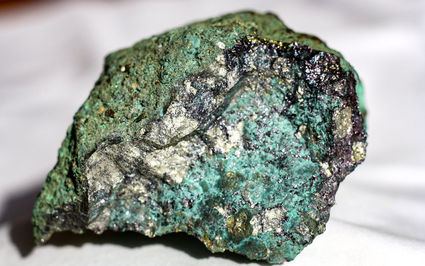
Shane Lasley
A sample of the copper- and cobalt-rich mineralization extracted from an exploration shaft Kennecott Exploration sunk into the Bornite deposit in Northwest Alaska during the 1960s.
Historical samples collected from the Cap prospect at Palmer returned 0.013 percent cobalt, along with silver, zinc, gold and barite. Samples from the Jarvis Glacier prospect at Palmer returned 0.016 percent cobalt, along with copper, zinc, silver and gold.
Some of the highest grade cobalt samples in the area were collected from the Claire Bear occurrence, which is on the Haines Block lands Constantine leased from the Alaska Mental Health Trust in 2014.
Samples collected from Claire Bear contained up to 0.107 percent cobalt, 0.229 percent copper, 0.07 percent tin, 0.1 percent bismuth and 0.7 percent antimony.
The potential for existing and future VMS mines in Southeast Alaska to produce cobalt, coupled with the cobalt prospectivity of this battery metal being associated with the many PGM-nickel prospects along this stretch of the Wrangellia Terrane, makes the panhandle another potential Alaska source of critical cobalt.



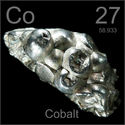
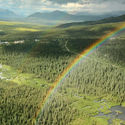
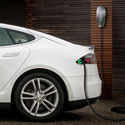
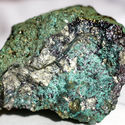















Reader Comments(0)